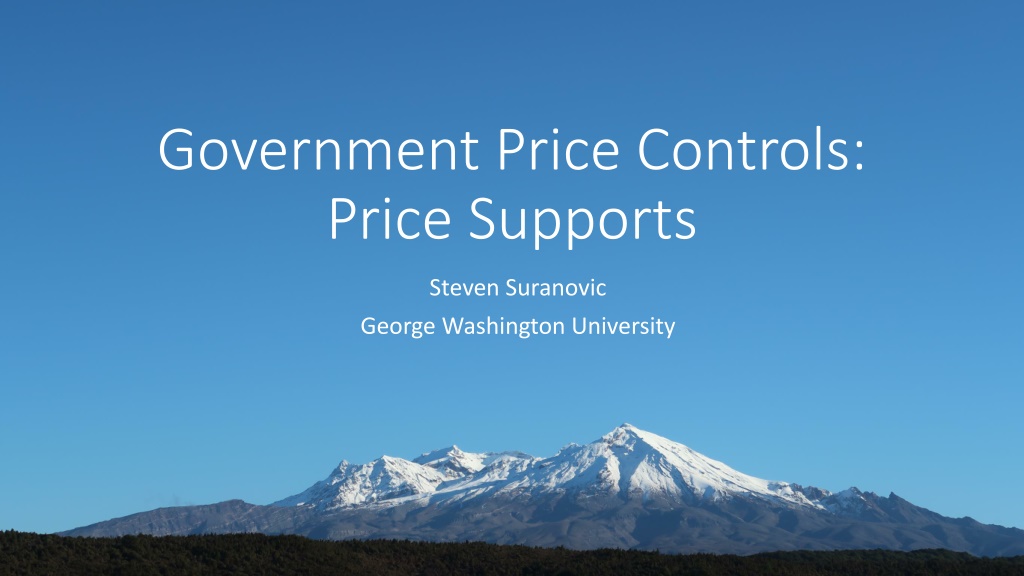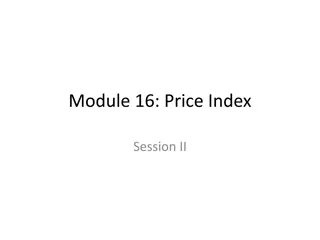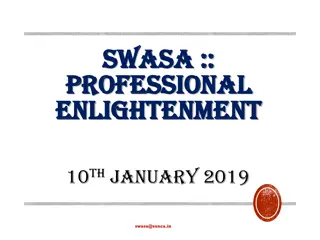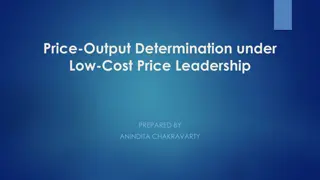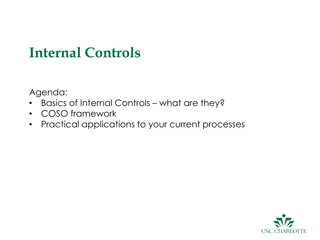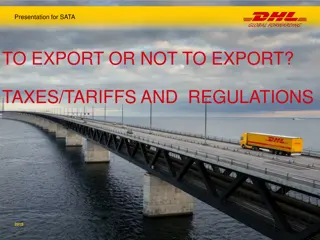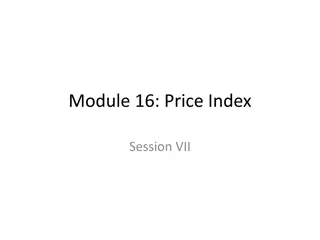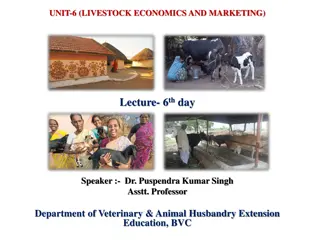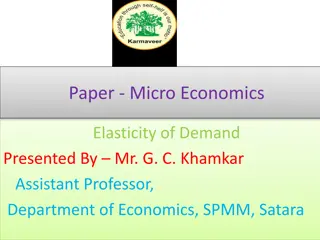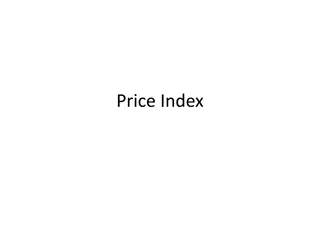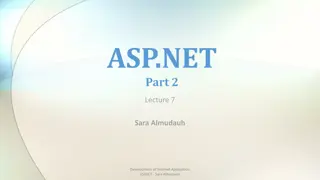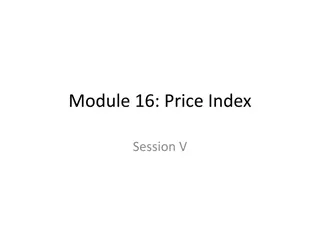Government Price Controls & Supports
Types of government price controls include price ceilings, price floors, and price supports, with a focus on agricultural products. Price supports ensure income guarantees for farmers by setting minimum prices and purchasing excess supply. The effects of price supports can impact welfare, with consumers losing out while producers benefit, leading to negative net welfare effects. However, these losses can be mitigated if the government sells the purchased goods later at prices covering production costs.
Download Presentation

Please find below an Image/Link to download the presentation.
The content on the website is provided AS IS for your information and personal use only. It may not be sold, licensed, or shared on other websites without obtaining consent from the author.If you encounter any issues during the download, it is possible that the publisher has removed the file from their server.
You are allowed to download the files provided on this website for personal or commercial use, subject to the condition that they are used lawfully. All files are the property of their respective owners.
The content on the website is provided AS IS for your information and personal use only. It may not be sold, licensed, or shared on other websites without obtaining consent from the author.
E N D
Presentation Transcript
Government Price Controls: Price Supports Steven Suranovic George Washington University
Types of Government Price Controls Types of Government Price Controls Price Ceiling (L20) a maximum price that can be charged for a product in a market Price Floor (L21) a minimum price that can be charged for a good or service in a market Price Support (L22) a price floor for a good in which the government purchases excess supply
Price Supports Price Supports Commonly used for Agricultural products The intention is to provide income guarantees for farmers Farmers that plant in the spring and harvest in the fall may discover the fall price to be too low to be profitable A price support offers a minimum price so farmers can plan more effectively a kind of insurance policy If there is excess supply, the government buys it Restricted to storable products; powdered milk, cheese, grain, butter, etc
Effects of a Price Support Effects of a Price Support Consider a price support for a product set at PS Suppose the free market price at harvest is PE At PS, supply will be Q1 At PS, demand will be Q0 At PS, excess supply is Q1 Q0
Effects of a Price Support Effects of a Price Support Welfare Effects CS = - (b + c) PS = + b + c + d GR = - (c + d + f + i + j + g) MW = - (c + f + i + j + g)
Effects of a Price Support Effects of a Price Support Welfare Effects Consumers of the exported good lose Producers of the exported good benefit Taxpayers must pay the government more The net welfare effect is negative Losses exceed the gains
Effects of a Price Support Effects of a Price Support Note that the losses to the taxpayers is exaggerated because it presumes the good is thrown away. If the government purchased good is sold later, at a price that covers the variable production costs, then GR = - (c + d + f) and MW = - c - f
Political Economy Issues Political Economy Issues Why do governments often choose to implement policies that are welfare reducing? Why implement a price support if it results in more harm than good? Why implement an import tariff if it causes more harm than good? Why maintain strong intellectual property protections if the intended stimulus to innovation is weak or non-existent?
Political Economy Issues Political Economy Issues Mancur Olson (1932 1998) The Logic of Collective Action (1965) Collective action refers to lobbying the government Central Result: Small-sized groups are more effective than large-sized groups Reason is that large groups suffer from coordination problems and free-riding
Political Economy Issues Political Economy Issues Coordination Problems How do you get a group of people with shared interests to participate in a collective action? If the self-interests of each member is large, it is easier to do Free Rider Problem If a few people volunteer to support the collective interests, others might decide to opt out Free riding is more likely the larger the group
Political Economy Issues Political Economy Issues In economic models, winners and losers from policy actions can be classified into three groups: Producers relatively small-sized, concentration in an industry may result in numbers between 10-1000 Consumers Large-sized. In US the number of consumers is in the millions to hundreds of millions Taxpayers Large-sized. All adults pay taxes in one form or another .. numbers in the hundreds of millions in the US
Constructed Numerical Example Constructed Numerical Example Consider a price support in the market for butter. PS= $1.05 Numbers used are approximately equal to real values in the butter market Note that axes are not to scale
Constructed Numerical Example Constructed Numerical Example Calculate consumer surplus changes CS = - (b + c) = - (1.05 - .90)(3,000,000) - (.15)(3,500,000 3,000,000) = - $487,500 per week Or - $25.35 million per year
Constructed Numerical Example Constructed Numerical Example Calculate producer surplus changes PS = + (b + c + d) = = $487,500 + (.15)(4,000,000 3,000,000) = + $562,500 per week Or + $29.25 million per year
Constructed Numerical Example Constructed Numerical Example Calculate government revenue changes GR = - (c + f + i + g + j) c = (.15)(500,000) = $37,500 f + i = (.90)(500,000) = $450,000 Also, c + f + i = g +j = $487,500 Thus GR = - $975,000 per week or - $50.7 million per year
Constructed Numerical Example Constructed Numerical Example Market Welfare = CS + PS + GR = - 487,500 + 562,500 - 975,000 = - $900,000 per week Or - $46.8 million per year
Constructed Numerical Example Constructed Numerical Example Suppose there are 25 major butter firms 200 million consumers 300 million taxpayers Annual impact per unit + $1.17 million per firm per year Concentrated Benefits - $0.13 per consumer per year Dispersed losses - $0.17 per year per taxpayer Dispersed losses
Lobbying Effects in a Democracy Lobbying Effects in a Democracy In the US, every person has the right to petition the government Representatives are elected to promote the interests of their constituents Suppose a price support policy for butter is under consideration Since the 25 Butter firms each stand to gain over $1 million dollars they can each pledge some fraction to give to the butter trade association. The assn. can lobby representatives to support the policy Consumers and taxpayers will never know they will be negatively affected and cannot collectivize and raise money easily Hence, politicians only hear from firms
Lobbying Effects in a Democracy Lobbying Effects in a Democracy The implication is that politicians, who open their doors for all constituents, will only hear from the industry group Politicians will hear info that is tilted in favor of the firm interests Policy will help the butter manufacturers It will create jobs Little mention will be made about the likely consumer/aggregate effects This means that a democracy will tend to implement economic policies that favor concentrated beneficiaries (almost always firms) (a.k.a. crony capitalism)
Lobbying Effects in a Democracy Lobbying Effects in a Democracy Lobbying sometimes called a Directly Unproductive Activity (DUP) Lobbying is also called rent-seeking References to K St in DC is to this group of trade assns. and lobby groups DUPs do not create anything new instead they work to transfer money to their interest group Oftentimes these actions result in economic inefficiencies the overall losses exceed the gains There are some exceptions as when lobbying promotes improvements in economic efficiency (e.g free trade promotion or environmental regulation)
Lobbying Effects in a Democracy Lobbying Effects in a Democracy Note the following Wiki pages showing trade associations and business interest groups List of industry trade groups in the United States Compare with the Wiki page showing consumer oriented interest groups Consumer Organizations in the US
Believing Unnoticed Effects Believing Unnoticed Effects For most economic policies, some of the effects will be unnoticeable which means to incorporate them, one must have faith, or believe, in the economic theory identifying them. Similar to the acceptance of global climate change No one person can experience GCC Recent hurricanes, forest fires, droughts, or floods are not the scientific proof of GCC because they only reflect variations in local climates One needs to trust the things they ve read, which in turn reports the findings of others. Must trust the honest processing of info. (eg. IPCC reports for GCC)
Believing Unnoticed Effects Believing Unnoticed Effects What if the unnoticed effects are not believed, or not known? Then decisions will be made on the basis of partial facts Inefficient, or general welfare reducing outcomes more likely to occur Beneficiaries of inefficient outcomes (usually firms) may steer discussion of the issue to their own favor. E.g. say that the policy will create more jobs . but do not mention the higher prices to consumers. (afterall, consumers will not feel it) Talk abt the benefits of newly budgeted government programs, but don t talk much about higher taxes to pay for it.
Another Example Another Example US Sugar Supports US Sugar Supports Consumers lose an estimated $2 - $4 billion per year 42% of Sugar subsidies go to 5% of sugar growers Fanjul (sugar) Family in Florida make sizeable campaign contributions regularly Estimates are they make ~ $60 million in government subsidies per year Only 61,000 jobs in the sugar industry in US Most US Free trade agreements have sugar exceptions US sugar price approx. twice the world price These are from random internet sources circa 2015. They should be verified before quoting.
